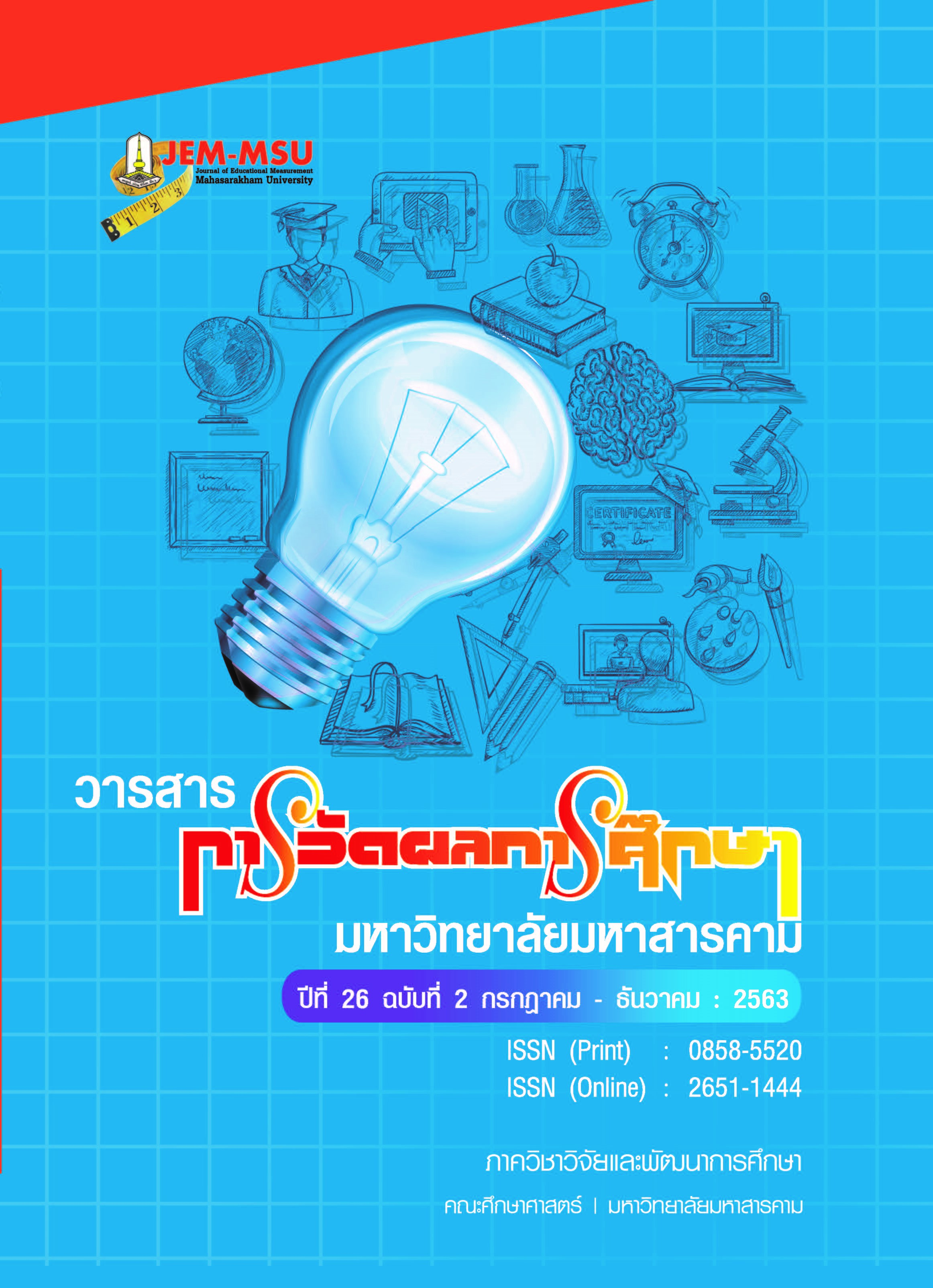Analysis of Confirmatory Factors of Information Technology and Communication (ICT) Competencies of the 21st Century for Grade 9 Students
Main Article Content
Abstract
The purposes of this study were: (1) to investigate factors and indicators of information technology and communication competency of grade 9 students from a conceptual framework; and (2) to verify the correlation between the components and indicators of the conceptual framework and the empirical data. The sample consisted of 300 grade 9 students in educational opportunity-extension schools under Khon Kaen Primary Education Service Area Office 5, in the second semester of the academic year 2018, obtained through multi-stage random sampling. The instrument was a 4-choice test on information technology and communication competency, having 24 items. The data were analyzed by using descriptive statistics and confirmatory factor analysis. The correlation of the model of the information technology and communication competency and empirical data were calculated with a computer statistic package.
The results of the study revealed that: (1) the information technology and communication competency consisted of 3 components and 8 indicators as follows: component 1, knowledge, had 2 indicators; component 2, skills, had 4 indicators; and component 3, attitude, had 2 indicators. (2) the analysis of the confirmatory factor analysis indicated that the factors and indicators of the information technology and communication competency model was consistent with the empirical data with = 561.771, p-value = 0.071, df = 28, X2/df = 1.624, CFI = 0.985, and TLI = 0.967 which exceeded 0.950 and approached 1. It could indicate that the two data were in line. The data were consistent with the conceptual framework as Standardized Root Mean Square Residual (SRMR) was found at 0.027 and Root Mean Square Error of Approximation (RMSEA) was found at 0.046 which was below 0.050 and approached 0. This indicated a low level of error in the parameter estimation. Moreover, the beta levels (
) of the indicators were found between 0.754 and 1.000 at the statistical significance level of .01 in every component. The indicators with the highest beta level were judgment and responsibility, ICT knowledge, accessibility and data collection, and awareness.
Article Details
The content and information contained in the published article in the Journal of Educational Measurement Mahasarakham University represent the opinions and responsibilities of the authors directly. The editorial board of the journal is not necessarily in agreement with or responsible for any of the content.
The articles, data, content, images, etc. that have been published in the Journal of Educational Measurement Mahasarakham University are copyrighted by the journal. If any individual or organization wishes to reproduce or perform any actions involving the entirety or any part of the content, they must obtain written permission from the Journal of Educational Measurement Mahasarakham University.
References
กระทรวงเทคโนโลยีสารสนเทศและการสื่อสาร. (2554). กรอบนโยบายเทคโนโลยีสารสนเทศและการสื่อสาร ระยะ พ.ศ. 2554-2563 ของประเทศไทย. กรุงเทพมหานคร : กระทรวงเทคโนโลยีสารสนเทศและการสื่อสาร.
กระทรวงศึกษาธิการ. (2560). ตัวชี้วัดและหลักสูตรแกนกลาง (ฉบับปรับปรุง พ.ศ. 2560) ตามหลักสูตรแกนกลางการศึกษาขั้นพื้นฐาน พุทธศักราช 2551.สำนักคณะกรรมการศึกษาขั้นพื้นฐานกระทรวงศึกษาธิการ. กรุงเทพมหานคร : โรงพิมพ์ชุมนุมสหกรณ์การเกษตรแห่งประเทศไทย จํากัด.
นงลักษณ์ วิรัชชัย. (2551). การวิจัยและตัวบ่งชี้คุณธรรมจริยธรรม. กรุงเทพฯ : ศูนย์ส่งเสริมและพัฒนา.พลังแผ่นดินเชิงคุณธรรม (ศูนย์คุณธรรม) ส านักงานบริหารและพัฒนาองค์ความรู้ (องค์การมหาชน).
น้ำทิพย์ องอาจวาณิชย์. (2556). การพัฒนาแบบวัดทักษะแห่งศตวรรษที่ 21 ตามการรับรู้ของนักเรียนมัธยมศึกษาตอนต้น: การประยุกต์ใช้แนวคิดการเข้าถึงคุณลักษณะที่มุ่งวัดของแบบสอบ. วิทยานิพนธ์ปริญญาดุษฎีบัณฑิต, สาขาวิชาวิธีวิทยาการวิจัยการศึกษา คณะครุศาสตร์ จุฬาลงกรณ์มหาวิทยาลัย.
วันดี โค้ไพบูลย์. (2555). สมรรถนะไอซีทีของนักเรียนมัธยมศึกษาตอนต้น:โมเดลสมการโครงสร้างพหุระดับที่มีและไม่มีการส่งผ่านที่ถูกกำกับ. วิทยานิพนธ์ปริญญาดุษฎีบัณฑิต, สาขาวิชาวิธีวิทยาการวิจัยการศึกษา คณะครุศาสตร์ จุฬาลงกรณ์มหาวิทยาลัย.
European Schoolnet, Belgium. (2005). National ICT Policies. [Online]. Available from : http://insight.eun.org [accessed 3 May 2019].
Bembridge, E., Levett-Jones, T., & Jeong, S. Y . S. (2011). The Transferability of Information and Communication Technology Skills from University to The Workplace: A Qualitative Descriptive Study. Nurse Education Today, 31(3), 245-252.
Gudmundsdottir, G. B. (2010). From Digital Divide to Digital Equity: Learners’ ICT Competence in Four Primary Schools in Cape Town, South Africa. International Journal of Education and Development using Information and Communication Technology (IJEDICT), 6, 21-22.
Hair, J.F., Anderson, R.E., Tatham, R.L., & Black, W.C. (1998). Multivariate Data Analysis. 5th ed. Upper Saddle River, NJ: Prentice Hall.
Inan, F. A., Lowther, D. L., Ross, S. M., & Strahl, D. (2010). Pattern of classroom activities during students’ use of computers: relations between instructional strategies and computer applications. Teaching and Teacher Education, 26(3), 540–546.
Kennewell, S., & Morgan, A. (2006). Factors Influencing Learning through Play in ICT Settings. Computers & Education, 46(3), 265-279.
Lai, C., Wang, Q., & Lei, J. (2012). What Factors Predict Undergraduate Students' Use of Technology for Learning? A Case from Hong Kong. Computers & Education, 59(2), 569-579.
Park, S. Y., Nam, M. W., & Cha, S. B. (2012). University Students' Behavioral Intention to Use Mobile Learning: Evaluating the Technology Acceptance Model. British Journal of Educational Technology, 43(4), 592-605.
Schumacker, R. E. & Lomax, R. G. (1996). A Beginner’s Guide to Structural Equation Modeling. Mahwah, NJ: Lawrence Earlbaum.
UNESCO. (2008). ICT Competency Standards for Teacher: Policy Framework. Available from : http://unesdoc.org/images/0015/001562/15610E.pdf [accessed 11 December 2018].
UNESCO. (2008). ICT Competency Standards for Teachers: Competency Standard Modules [Online]. Available from : http://unesdoc.unesco.org/images/0015/001562/156207e.pdf [accessed 11 December 2018]
Verhoeven, J. C., Heerwegh, D., & Wit, K. D. (2010). First Year University Students’ Self Perception of ICT Skills: Do Learning Styles Matter?. [Online]. Available from : https://lirias.kuleuven.be/bitstream/123456789/291766/1/LearningStyles.pdf [accessed 11 December 2019].


